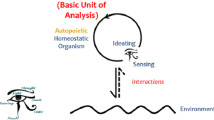Abstract
Distributed cognition is widely recognized as an approach to the study of all cognition. It identifies the distribution of cognitive processes between persons and technology, among people, and across time in the development of the social and material contexts for thinking. This paper suggests an ectoderm-centric perspective as the basis for distributed cognition, and in so doing redefines distributed cognition as the ability of an organism to interact with its environment for the purpose of satisfying its most basic physiological (internal and external) and social needs in order to survive and sustain itself. Underlying this ectoderm-centric perspective is a proposed theory of reactive and interactive learning.


Similar content being viewed by others
References
Bach-Y-Rita, P. (2004). Tactile sensory substitution studies. Annals of the New York Academy of Sciences, 1013, 83–91.
Bargh, J. A. (2011). Unconscious thought theory and its discontents: a critique of the critiques. Social Cognition, 29(6), 629–647.
Bargh, J. A., & Morsella, E. (2009). Unconscious behavioral guidance systems. In C. R. Agnew, D. E. Carlston, W. G. Graziano, & J. R. Kelly (Eds.), Then a miracle occurs: Focusing on behavior in social psychological theory and research. New York: Oxford University Press.
Bates, M. J. (2005). Information and knowledge: an evolutionary framework for information science. Information Research, 10(4), Paper 239. http://InformationR.net/ir/10-4/paper239.html. Accessed 22 Feb 2013.
Bates, M. J. (2006). Fundamental forms of information. Journal of the American Society for Information Science and Technology, 57(8), 1033–1045.
Carey, B. (2007, July 31). Who’s minding the mind? New York Times.
Damasio, A. (2010). Self comes to mind: Constructing the conscious brain. New York: Pantheon Books.
Dennett, D. C. (1991). Consciousness explained. Boston: Little, Brown and Company.
Dijksterhuis, A., & Nordgren, L. F. (2006). A theory of unconscious thought. Perspectives on Psychological Science, 1(2), 95–109.
Einstein, A. (1934). On the method of theoretical physics. Philosophy of Science, 1(2), 163–169.
Field, T. (2001). Touch. Cambridge: The MIT Press.
Gazzaniga, M. S., Ivry, R. B., & Mangun, G. R. (2002). Cognitive neuroscience: The biology of the mind (2nd ed.). New York: W. W. Norton.
Hawkins, J., & Blakeslee, S. (2004). On intelligence. New York: Times Books, Henry Holt and Company, LLC.
Holloway, R. L. (1981). Culture, symbols and human brain evolution: a synthesis. Dialectical Anthropology, 5, 287–303.
Hutchins, E. (1994). Cognition in the wild. Cambridge: MIT Press.
Maturana, H. R., & Varela, F. J. (1980). Biology of cognition. In Autopoiesis and cognition: The realization of the living (pp. 5–58). Dordrecht, Holland: D. Reidel Publishing Company.
Maturana, H. R., & Varela, F. J. (1987). The tree of knowledge–the biological roots of human understanding. Boston: New Science Library.
Miller, G. A. (2003). The cognitive revolution: a historical perspective. Trends in Cognitive Science, 7(3), 141–144.
Minsky, M. (1988). The society of mind. New York: Simon & Schuster, Inc.
Minsky, M. (1991, June). Conscious machines. Paper presented at the 75th Anniversary Symposium on Science in Society: Machinery of Consciousness.
Minsky, M. (2006). The emotion machine: Commonsense thinking, artificial intelligence, and the future of the human mind. New York: Simon & Schuster.
Montagu, A. (1978). Touching: The human significance of the skin (2nd ed.). New York: Harper & Row Publishers, Inc.
Moore, K. L., & Persaud, T. V. N. (2003). The developing human: Clinically oriented embryology. Philadelphia: Saunders.
Nardi, B. A. (1996). Concepts of cognition and consciousness: four voices. Australian Journal of Information Systems, 4(1), 64–79.
Newton, I. (1959). The correspondence of Isaac Newton (Vol. I).
Robles-De-La-Torre, G. (2006). Special issue on haptic user interfaces for multimedia systems: the importance of the sense of touch in virtual and real environments. IEEE Multimedia, 13(3), 24–30.
Thagard, P. (Fall 2008 Edition). Cognitive science. In E. N. Zalta (Ed.), The Stanford encyclopedia of philosophy. URL: {http://plato.stanford.edu/archives/fall2012/entries/cognitive-science/}.
Trewavas, A. J., & Baluska, F. (2011). The ubiquity of consciousness. European Molecular Biology Organization Reports, 12(12), 1221–1225.
Acknowledgments
The author would like to acknowledge the helpful discussions, comments and suggestions by J. Fonseca that helped focus the content in several sections of this paper.
Author information
Authors and Affiliations
Corresponding author
Additional information
Special Issue “Origins of Mind” edited by Liz Stillwaggon Swan and Andrew M. Winters
Rights and permissions
About this article
Cite this article
Cárdenas-García, J.F. Distributed Cognition: An Ectoderm-Centric Perspective. Biosemiotics 6, 337–350 (2013). https://doi.org/10.1007/s12304-013-9166-8
Received:
Accepted:
Published:
Issue Date:
DOI: https://doi.org/10.1007/s12304-013-9166-8




